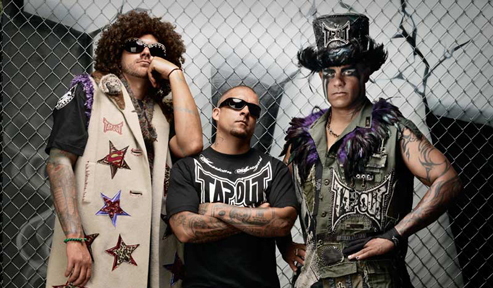The History of TapouT
In 1997, entrepreneurs Charles Lewis, Jr. and Tim Katz noticed a huge gap in the marketplace when it came to merchandise tailored to MMA fighters and fans of the sport. That's when they came up with the idea for TapouT and brought in investors and creative thinkers, one of which was Dan Caldwell who would take the helm as the CEO of TapouT later in the same year.
The operation started small, mostly around the mixed martial arts scene in Las Vegas, with t-shirts and other merchandise being sold out of the back of a car at small events, training centers and niche MMA hubs in the local area. As sales began to pick up, Caldwell and Lewis began expanding into other markets where MMA fights and training studios had gained a foothold with the local populace.

The brand remained small and centered on sales at smaller MMA events and training centers until the sport's popularity began to explode in the United States and other parts of the world. The minds behind TapouT Clothing took advantage of the growth of the sport and the lack of merchandise marketed towards fans and fighters to increase sales and dominate the MMA clothing market. By 2007, TapouT Clothing was the largest manufacturer of MMA related clothing and merchandise pulling revenues estimated to
be over 22.5 million dollars.
The upward trend did not stop there, however. In coordination with the previously created TapouT Films, the clothing brand gained major mainstream exposure starting in 2007 with the debut of the TapouT reality show on the Versus network. The show aired for two seasons and brought brand awareness to both hardcore MMA fans and the casual TV viewer who tuned in to observe this intriguing look into the MMA world.
In March of 2015, the WWE and the Authentic Brand Group invested in TapouT Clothing, each purchasing 50 percent of the company. Even though they were already a well-known clothing brand, this gave the TapouT brand access to a much larger base and opened up the opportunity to explore the creation of supplements, branded gyms and training centers, TapouT sports beverages and various other products outside of clothing and other MMA related merchandise. During this transition, the marketing focus of TapouT shifted to a much larger demographic outside of the MMA world reaching all types of athletes, trainers, fitness professionals and those interested in a healthy and fit lifestyle.
Whether sold out of the back of the car in the early stages or mass-marketed to over a billion connections worldwide via social media, television and other mainstream marketing outlets, the TapouT brand has stood for authenticity, performance and putting 100-percent effort into every training session, athletic competition and living the fittest lifestyle one can live.
The History of TapouT
In 1997, entrepreneurs Charles Lewis, Jr. and Tim Katz noticed a huge gap in the marketplace when it came to merchandise tailored to MMA fighters and fans of the sport. That's when they came up with the idea for TapouT and brought in investors and creative thinkers, one of which was Dan Caldwell who would take the helm as the CEO
of TapouT later in the same year.
The operation started small, mostly around the mixed martial arts scene in Las Vegas, with t-shirts and other merchandise being sold out of the back of a car at small events, training centers and niche MMA hubs in the local area. As sales began to pick up, Caldwell and Lewis began expanding into other markets where MMA fights and training studios had gained a foothold with the local populace.

The brand remained small and centered on sales at smaller MMA events and training centers until the sport's popularity began to explode in the United States and other parts of the world.
The minds behind TapouT Clothing took advantage of the growth of the sport and the lack of merchandise marketed towards fans and fighters to increase sales and dominate the MMA clothing market. By 2007, TapouT Clothing was the largest manufacturer of MMA related clothing and merchandise pulling revenues estimated to
be over 22.5 million dollars.
The upward trend did not stop there, however. In coordination with the previously created TapouT Films, the clothing brand gained major mainstream exposure starting in 2007 with the debut of the TapouT reality show on the Versus network. The show aired for two seasons and brought brand awareness to both hardcore MMA fans and the casual TV viewer who tuned in to observe this intriguing look into the MMA world.
In March of 2015, the WWE and the Authentic Brand Group invested in TapouT Clothing, each purchasing 50 percent of the company. Even though they were already a well-known clothing brand, this gave the TapouT brand access a much larger base and opened up the opportunity to explore the creation of supplements, branded gyms and training centers, TapouT sports beverages and various other products outside of clothing and other MMA related merchandise. During this transition, the marketing focus of TapouT shifted to a much larger demographic outside of the MMA world reaching all types of athletes, trainers, fitness professionals and those interested in a healthy and fit lifestyle.
Whether sold out of the back of the car in the early stages or mass-marketed to over a billion connections worldwide via social media, television and other mainstream marketing outlets, the TapouT brand has stood for authenticity, performance and putting 100-percent effort into every training session, athletic competition and living the fittest lifestyle one can live.
The History of TapouT
In 1997, entrepreneurs Charles Lewis, Jr. and Tim Katz noticed a huge gap in the marketplace when it came to merchandise tailored to MMA fighters and fans of the sport. That's when they came up with the idea for TapouT and brought in investors and creative thinkers, one of which was Dan Caldwell who would take the helm as the CEO of TapouT later in the same year.
The operation started small, mostly around the mixed martial arts scene in Las Vegas, with t-shirts and other merchandise being sold out of the back of a car at small events, training centers and niche MMA hubs in the local area. As sales began to pick up, Caldwell and Lewis began expanding into other markets where MMA fights and training studios had gained a foothold with the local populace.

The brand remained small and centered on sales at smaller MMA events and training centers until the sport's popularity began to explode in the United States and other parts of the world. The minds behind TapouT Clothing took advantage of the growth of the sport and the lack of merchandise marketed towards fans and fighters to increase sales and dominate the MMA clothing market. By 2007, TapouT Clothing was the largest manufacturer of MMA related clothing and merchandise pulling revenues estimated to be over 22.5 million dollars.
The upward trend did not stop there, however. In coordination with the previously created TapouT Films, the clothing brand gained major mainstream exposure starting in 2007 with the debut of the TapouT reality show on the Versus network. The show aired for two seasons and brought brand awareness to both hardcore MMA fans and the casual TV viewer who tuned in to observe this intriguing look into the MMA world.
In March of 2015, the WWE and the Authentic Brand Group invested in TapouT Clothing, each purchasing 50 percent of the company. Even though they were already a well-known clothing brand, this gave the TapouT brand access a much larger base and opened up the opportunity to explore the creation of supplements, branded gyms and training centers, TapouT sports beverages and various other products outside of clothing and other MMA related merchandise. During this transition, the marketing focus of TapouT shifted to a much larger demographic outside of the MMA world reaching all types of athletes, trainers, fitness professionals and those interested in a healthy and fit lifestyle.
Whether sold out of the back of the car in the early stages or mass-marketed to over a billion connections worldwide via social media, television and other mainstream marketing outlets, the TapouT brand has stood for authenticity, performance and putting 100-percent effort into every training session, athletic competition and living the fittest lifestyle one can live.
